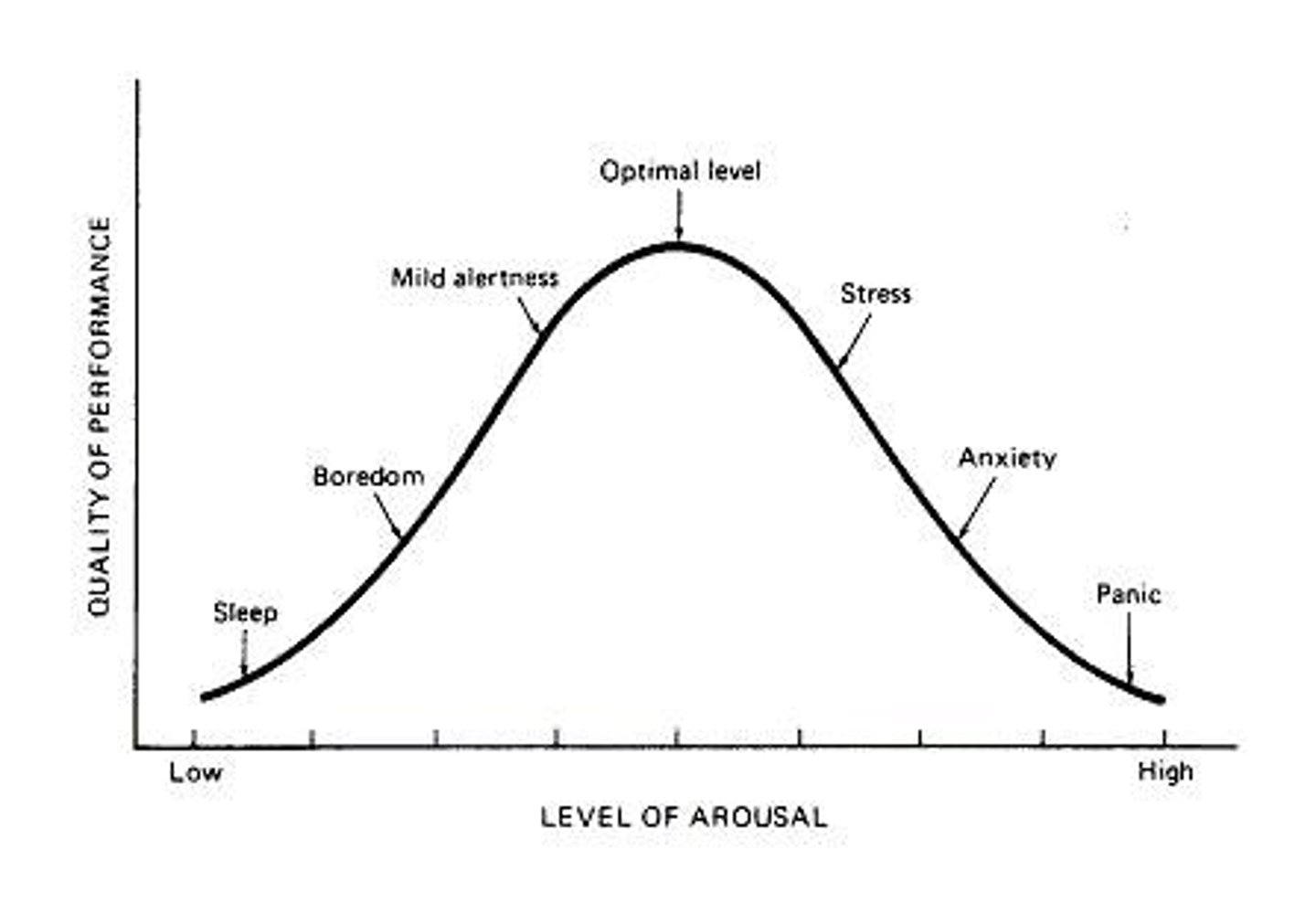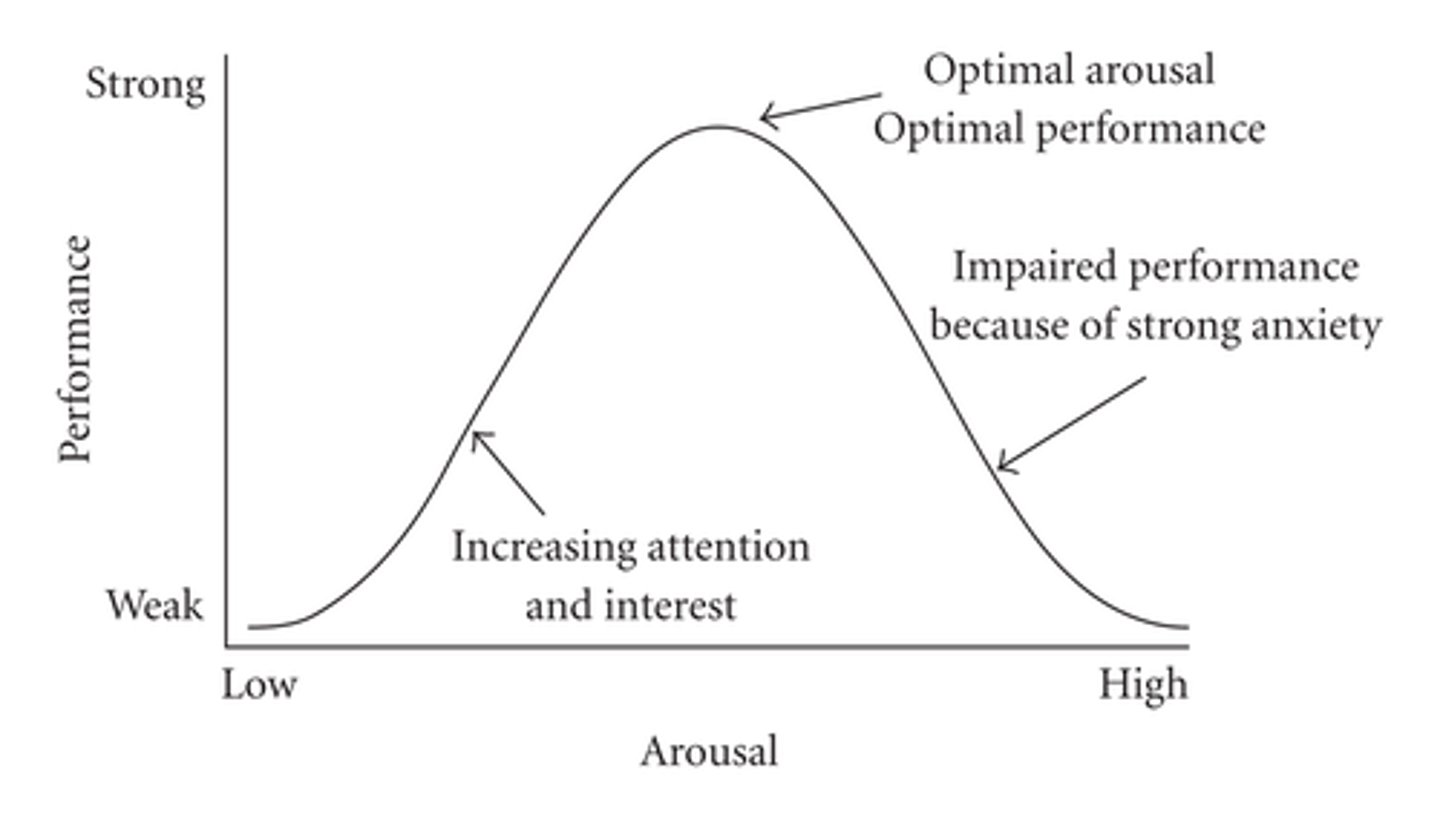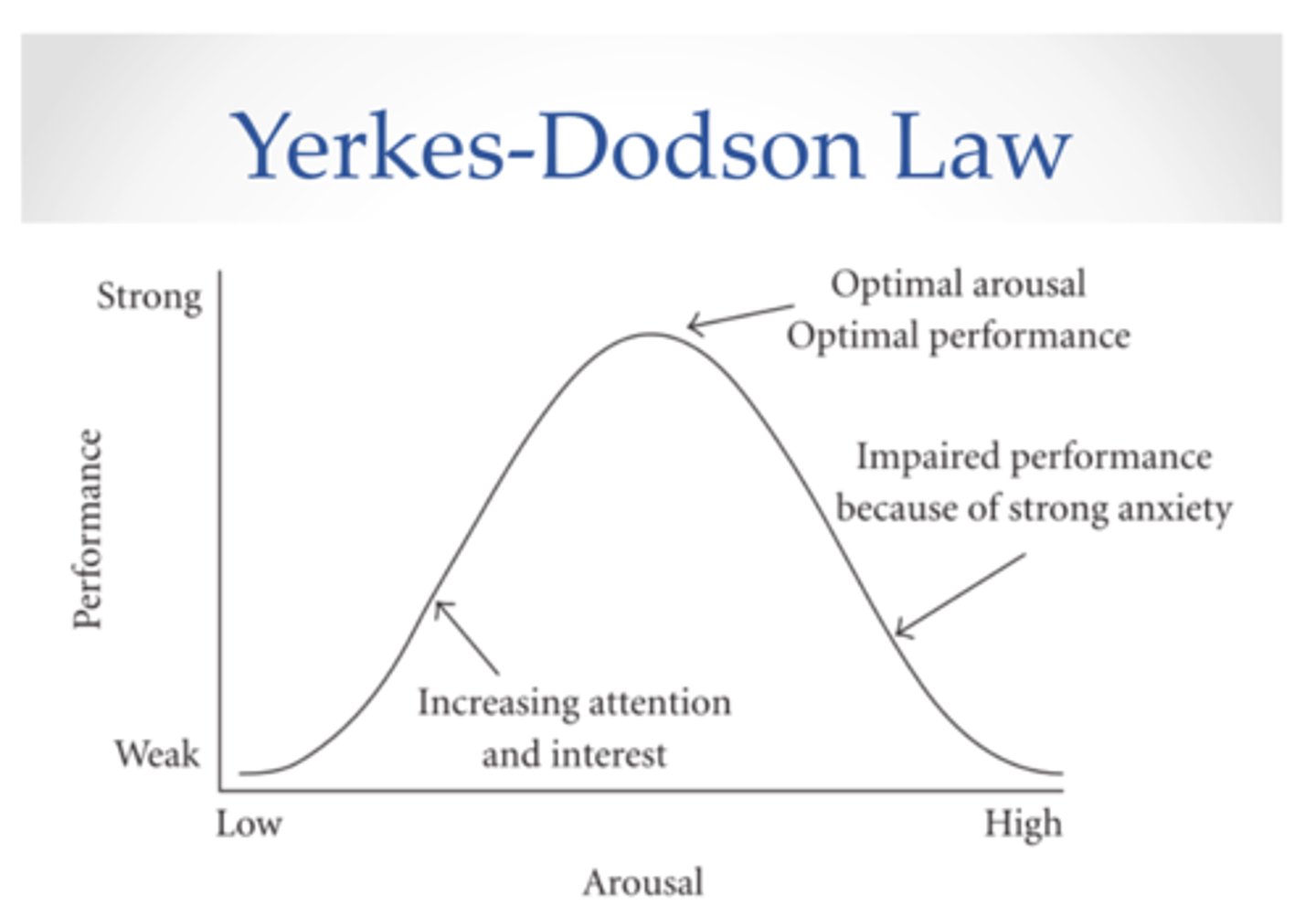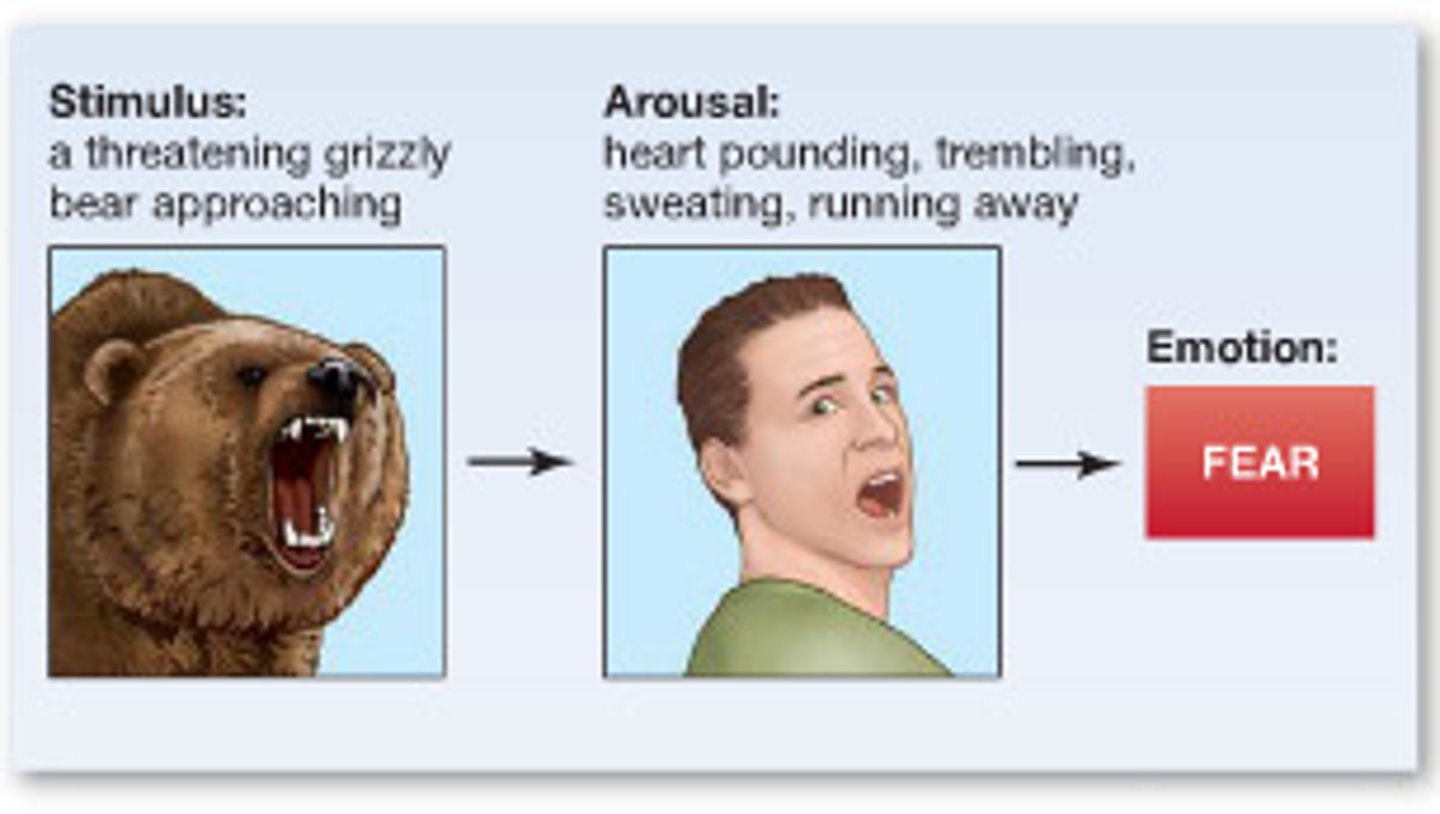PSYCH 1010 Test 3
1/287
There's no tags or description
Looks like no tags are added yet.
Name | Mastery | Learn | Test | Matching | Spaced |
|---|
No study sessions yet.
288 Terms
What are the 6 major approaches for motivation?
Instinct, drive-reduction, arousal, incentive, cognitive, Maslow's hierarchy of needs
Motivation: instinct
unlearned patterns of responding, innate behaviours for survival
Motivation: what are 3 things that instinct theory can't explain?
1)there isn't consensus on how many primary instincts exist
2) doesn't clearly explain why behaviour patterns are in one species but not another
3) human behaviour isn't entirely instinctual because of complexity and variety.
Motivation: Drive Reduction
- motivational (aroused) states that result from unmet physical needs
- drives are created to maintain a balanced physiological state (homeostasis)
- e.g. hunger drive (as hunger increases, so does drive to eat)
Drive reduction: primary drive (give examples)
drives related to the biological needs or the needs of the species as a whole, e.g. hunger, sleep
Drive reduction: secondary drive (give examples)
drives that prior experience and learning bring, e.g. knowledge, achievement, finances
Instinct theory: baby reflexes
reflexes are unlearned, involuntary responses that happen when certain stimuli appear.
Name 5 baby reflexes
Rooting reflex, sucking reflex, gag reflex, startle reflex, Babinski reflex
Baby reflexes: Babinski
toes fan out when sole of foot is touched
Baby Reflexes: Rooting
babies turn their heads towards things that touch their cheeks, e.g. nipple or bottle
Baby Reflexes: sucking
sucking at things that touch their lips
Baby reflexes: gag reflex
clearing the throat
Baby reflexes: startle reflex (3 parts)
series of movements where baby flings out the arms, fans, fingers, arches back in response to sudden noise
Motivation: how is drive reduction a form of negative feedback?
Unmet biological needs are "negative" feedback, discomfort (hunger) occurs until need is met.
Motivation: what is drive-reduction theory good at explaining?
Attempts to fill the theoretical gap with instinct theory. Good explanation of how primary drives motivate behaviour.
Motivation: what is something that drive reduction theory can't explain? (give example)
Can't fully explain a behaviour in which the goal is not to reduce a drive, but rather to maintain or even increase the level of excitement or arousal, e.g. liking rollercoasters
Motivation: Arousal
People are motivated to maintain a level of arousal optimal for their functioning.

Motivation: what is the role of homeostasis in Arousal theory?
Homeostasis brings body functions back to normal using feedback loops. If our stimulation levels become too high, we try to reduce them. If the levels of stimulation are too low, we will try to increase them by seeking stimulation.

Motivation: what is the relationship between arousal level and performance? Give examples.
Increased arousal can help improve performance, but only up to a certain point. At the point when arousal becomes excessive, performance diminishes.
Example: An optimal level of stress can motivate you to study, but too much test anxiety can impair your ability to concentrate.

Motivation: Incentive theory
Motivation comes from desire for external rewards. This directs and energize behaviour (grades, money, love), even if we lack internal biological cues (see instinct theory or drive reduction theory)
Motivation: Cognitive Theory
Motivation is a product of people's thoughts, expectations, and goals—their cognitions. Distinguishes between intrinsic and extrinsic motivation.
Motivation: which theory focuses on intrinsic and extrinsic motivation?
Cognitive theory
Cognitive theory: why do we spend so little time on intrinsically valuable tasks?
We're more motivated in the long-term for intrinsic tasks, however offering rewards for desired behaviour may cause intrinsic motivation to decline and extrinsic motivation to increase.
Which motivational theories apply to hunger? (4 out of 6)
Instinct: we need to eat, it isn't learned behaviour
Drive reduction: hunger is a negative feedback loop until I'm full
Maslow: I have to fulfill the basic lower needs first
Cognitive: I'd rather eat a burger even if a salad is more nutritious, I can eat when I'm bored even if I'm not hungry
Motivation and the Need for Food: Why are other species far less likely to be obese?
Various internal mechanisms tell organisms when to stop eating. Many species choose a well-balanced diet despite offered a variety of food.
Motivation and the Need for Food: Weight set point theory
the weight level that a person is predisposed to maintain, controlled in part by the hypothalamus
Motivation and the Need for Food: hypothalamus hypothesis
Changes in blood sugar levels are monitored by the hypothalamus. Injury to the hypothalamus affects weight set point.
Motivation and the Need for Food: What are some examples of social factors in eating? (5 examples)
- Portion distortion. North American portions are too big.
- We eat on a schedule (e.g, lunch, dinner), even if we're not hungry.
- We put roughly the same amount of food on our plates every day regardless of activity level.
- We eat for comfort when we're bored or sad.
- We eat mindlessly, often while doing other things.
Motivation and obesity: settling point
a point at which a person's weight stabilizes, determined by genes and the environment.
Maslow's Hierarchy of Needs: name the 5 levels from bottom to top.
(level 1) Physiological Needs, (level 2) Safety and Security, (level 3) Relationships, Love and Affection, (level 4) Self Esteem, (level 5) Self Actualization
Motivation: What is a drawback to incentive theory?
We sometimes seek to fulfill needs even when incentives are not apparent
What are 4 reasons why is affiliation a fundamental human need? (hint: evolution)
1)We feel the need to associate and maintain social bonds.
2)Affiliation is not random -- individuals preferentially associate with others. 3)Through positive social interactions, you can predict future associations and interactions.
4)We form bonds easily and resist their dissolution.
Affiliation: what happens when we get rejected or ostracized?
Exclusion hurts, and we attempt to re-establish bonds.
On a biological level, what happens in the body when we feel lonely?
Feelings of loneliness trigger the release of stress hormones that in turn are associated with higher blood pressure, decreased resistance to infection, and increased risk of cardiovascular disease and cancer.
Need for affiliation: social capital definition
the networks of relationships among people who live and work in a particular society, enabling that society to function effectively.
What happens when humans experiences the loss of "social capital"?
They feel increasingly isolated and lonely. This leads to various health problems, such as shortened life expectancy.
Motivation: Need for power
the need to have control or influence over others
What jobs do people with a high need for power tend to do?
People with strong need for power are more likely to belong to organizations and seek office than are those low in need for power.
How do people with a high need for power "show" or "display" their power?
They own flashy possessions, such as sport cars or luxury handbags
What are 3 tendencies that men with a high need for power tend to have?
Men with high power needs tend to drink more heavily, act more aggressively, participate in competitive sports.
How do women express their high need for power?
Women with high power needs are more likely to channel those needs in a socially responsible actions like caring for others.
Motivation need for achievement
The extent to which an individual has a strong desire to perform challenging tasks well and to meet personal standards for excellence.
What are two characteristics that people with a high need for achievement tend to do? (hint: what situations do they seek out?)
1)seek out situations in which they can compete against a standard and prove themselves successful.
2)Avoid situations in which success is too easy, or situations where success is too hard
What are three characteristics that people with a low need for achievement tend to do? (hint: what situations do they seek out?)
1)Avoids failure with taking on easy tasks
2)Avoid failure
3)Seek out very difficult tasks for which failure has no negative outcomes.
Motivation: between low achievers and high achievers, who is most likely to take on extra difficult tasks and why?
Low achievement people take on extra difficult tasks, because they were going to 'fail' anyway if there's no negative outcomes. High achievement people go for moderately difficult tasks they want to succeed.
Motivation: settling point
a point at which a person's weight stabilizes in response to caloric intake and expenditure
What are 3 functions for emotions?
1)Prepares us for action, e.g. seeing an angry man approach me on the street
2)Shape our future behaviour: Act as reinforcement or punishment.
3)Help us to interact more effectively with others
How do emotions functionally "prepare us for action"?
Links events in our environment and with our responses.
How do emotions functionally "shape our future behaviour"?
Act as reinforcement or punishment.
How do emotions functionally "help us to interact more effectively with others"?
Act as a signal to observers, allowing them to better understand our experience and predict future behaviour
Ekman: what are the 6 fundamental emotions found in a lot of cultures?
happiness, sadness, fear, anger, surprise, disgust
What is one difficulty in categorizing the basic sets of emotions?
There's huge differences in descriptions of emotions across cultures, e.g. schadenfreude in German
True or false: Ekman's research points that cross-cultural emotional recognition varies widely.
FALSE: There's cross-cultural similarities in emotion recognition. HOWEVER, there are huge differences in how people think about, experience, regulate, & express emotions.
Emotions: display rules
culturally determined rules about which nonverbal behaviors are appropriate to display
nonverbal leakage
unconscious spillover of emotions into nonverbal behavior
Lisa Feldman Barrett: Theory of Constructed Emotion
- Theory of Constructed Emotion
- "what we call emotion is just a label that people apply a lot of different responses." Emotions aren't hardwired brain reactions, but rather a combination of psychological and physiological responses.
Lisa Feldman Barrett: What does she mean when "emotions that seem to be happening to you, are actually being made by you?" (Name 3)
-Emotions are guesses your brain constructs in the moment, and you actually have more control over those guesses.
-Using past experiences, your brain predicts and constructs your your experience of the world
-Emotions that you feel like you detect in others, are just inside your own head
Lisa Feldman Barrett: How are emotions just "educated guesses"?
The same physical sensation can lead to different experiences (e.g. heart racing due to a crush vs. being scared)
Susan David: emotional agility
the ability to respond positively and optimistically in a variety of social and emotional situations and to regain optimism when negative events occur.
Lisa Feldman Barrett vs. Susan David: what are their respective big ideas?
Barrett: emotions aren't real, they're just educated guesses
David: Emotions serve a function, toxic positivity is harmful
Lisa Feldman Barrett vs. Susan David: which person said "discomfort is the price of admission to a meaningful life?"
Susan David
James-Lange theory of emotion
theory in which a body reaction leads to the brain interpreting body changes as an emotional experience.
What are 2 flaws in the James-Lange theory of emotion?
1)Emotional experiences happen all the time before there's physical changes. 2)Physiological arousal doesn't equate to emotional experiences, e.g. My heart is pounding when I am exercising, but it doesn't mean that I experience fear

James-Lange theory of emotion: give an example and list the steps of what happens when we feel an emotion like fear
1: Stimulus--I see a scary bear
2: Arousal: body reactions like sweating, stomach feels uneasy, heart pounding
3: Emotion: I feel fear
Cannon-Bard Theory of Emotion
Body arousal and emotion are created at the same time by the same nerve stimulus in the thalamus. The body experience doesn't necessarily differ among various emotions.
Cannon-Bard theory of emotion: what's happening in the brain when we experience emotion?
Emotion occurs when the thalamus sends signals simultaneously to the cortex & autonomic nervous system. The messages sent to the cerebral cortex differ for each emotion, rather than different emotions having unique physical reactions.
Thalamus activation→Activation of bodily changes in response to brain+message to the cortex regard emotional experience
The Cannon-Bard theory attempts to address 3 different flaws in the James-Lange Theory. What are these 3 flaws?
1)Body changes can occur too slowly to trigger our emotional responses.
2)Body arousal can occur WITHOUT the experience of emotion (e.g., exercise and increased heart rate, doesn't mean I'm scared or angry)
3)Different emotions share the same body reactions (e.g., fear, joy, anger).
What are 2 flaws in the Cannon-Bard theory of emotion?
1)The theory asserts the thalamus is crucial in the emotional experience. However, it's the hypothalamus and limbic system, not the thalamus, manage emotions.
2)Simultaneous events of physiological and emotional responses are unproven. The Cannon-Bard relies hard on this assumption.
Cannon-Bard theory of emotion: give an example and list the steps of what happens when we feel an emotion like disgust
1: Stimuli--I see my date try to split the check
2:Thalamus activation
3: Activation of bodily changes in response to brain (tapping fingers impatiently, eyes looking for exits instead of him)+message to the cortex regard emotional experience (I feel disgust)
Motivation: What two biological factors may cause obesity?
1: a high weight set point, which is the weight the body attempts to maintain
2: genetic factors
Schachter-Singer Theory of emotion: give an example and list the steps of what happens when we feel an emotion like calm
1: Activation of general physiological arousal (slowed breathing, eyes closed) +observe environmental cues (I'm in a yoga class)
2: label the arousal, identifying an emotional experience (I feel calm)
Schachter-Singer Theory of emotion
2 psychological events are required to produce an emotion:
1. After an emotion-provoking event, it causes an ambiguous state of arousal.
2. Seeking understanding, we look to our external environment for cues and our cognitive interpretation of the arousal = our emotional experience.
Therefore, emotions are the labels we attach to our state of arousal.
Name 3 reasons why happiness is hard
1)Hedonic treadmill: the more you have the more you want, need greater thrills
2)Social comparison: tendency to compare oneself looking upwards
3)Asymmetry of affective experience: losing $50 feels worse than finding $50.
What indicators DO NOT correlate to happiness?
Money, age, parenthood, IQ, attractiveness
What indicators DO correlate to happiness?
Relationship satisfaction, work satisfaction, genetics, personality.
What indicators MODERATELY correlate to happiness?
Health, level of social activity, and religious affiliation.
Happiness: broaden and build theory
happiness predisposes us to think more openly.
Researchers have found that specific emotions produce activation of very different portions of the brain on PET scans. What are the implications found in the results of this finding? (Hint: the cortex and happiness/sadness)
Happiness was related to a decrease in activity in certain areas of the cerebral cortex, whereas sadness was associated with increases in activity in particular portions of the cortex.
Happiness: subjective well-being
self-perceived happiness or satisfaction with life. Used along with measures of objective well-being (for example, physical and economic indicators) to evaluate people's quality of life.
Researchers have found that specific emotions produce activation of very different portions of the brain on PET scans. What was the research process (what did they subject the participants to)?
Participants undergoing PET brain scans were asked to recall events, such as deaths and funerals, that made them feel sad, or events that made them feel happy, such as weddings and births.
Nature vs. Nurture: Heredity
the influences based on the genetic makeup of an individual that influence growth and development throughout life.
Nature vs. Nurture: Environment
the influence of parents, siblings, family, friends, schooling, nutrition, and all other experiences to which a child is exposed.
What is the current development psychology perspective on nature vs. nurture?
Rather than asking nature OR/VS. nurture, we now ask, how and to what degree do environment and heredity both produce their effects? (answer is that BOTH nature and nurture play a role)
Epigenetics
the study of environmental influences on gene expression that occur without a DNA change
In developmental psychology, what role does heredity play in our capabilities?
Heredity seems to define the upper limits of our growth
In developmental psychology, what role does environment play in our capabilities?
Environment affects the degree to which the upper limits of are abilities are reached.
Development: cross-sectional study
a study in which people of different ages are compared with one another at the same point in time
Development: longitudinal study
behavioural research in which the same people are restudied and retested over a long period of time, as the participants get older.
Development: sequential research
a research method that combines cross-sectional and longitudinal research by considering a number of different age groups and examining them at several points in time
Development: what sort of information does a cross-sectional study method provide?
Provides info on differences in development between different age groups, e.g. 25 & 12 yr olds.
Development: what sort of information does a longitudinal study method provide?
Traces behaviour over time as participants age. Assesses changes, unlike cross-sectional studies, which assess differences among groups at one time.
neonate
newborn baby
What are the 3 stages of prenatal development?
1)germinal/zygote (first 2 weeks)
2)embryonic (wks. 2-8)
3)fetal (8+wks)
What happens during the germinal stage?
The 2-week period of prenatal development that begins at conception. The zygote increases from 32 into 100-150 cells
What happens during the embryonic period?
the period from two to eight weeks after fertilization, during which the major organs and structures of the organism develop.
What happens during the fetal period?
Brain development. The third and longest period of prenatal development, extending from the ninth week until birth.
Development: Sensitive periods
Certain developing systems are vulnerable to mom's drug use during certain sensitive periods before birth, and less so before or after that sensitive period. Timing and exposure determines the significance and impact of which bodily systems are affected.
Teratogens
Agents, such as chemicals and viruses, that can reach the embryo or fetus during prenatal development and cause harm
Sensitive periods: the embryonic period
Considered critical because all major organs and physical structures are forming
Sensitive periods: the fetal period
The brain is even more sensitive during this period.